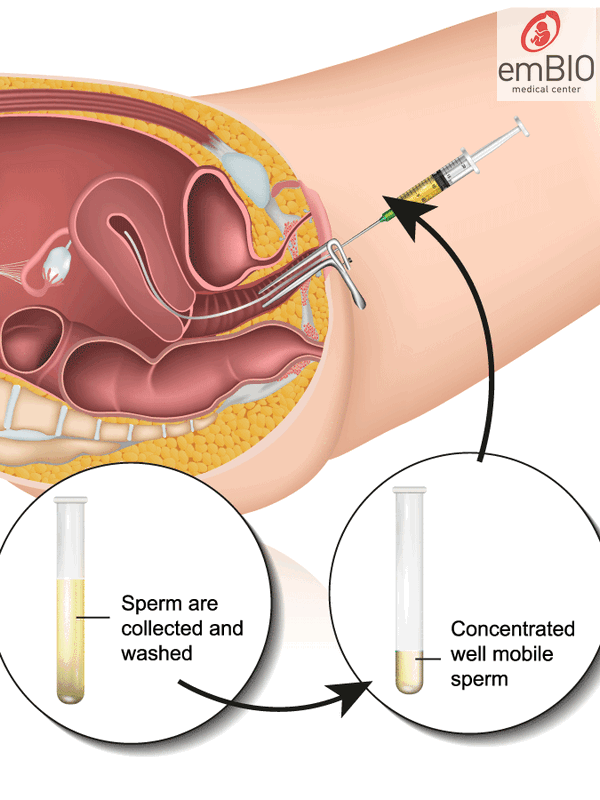Intrauterine Insemination - IUI Success Rates & Cost
Insemination is a simple procedure with few side effects and can help certain couples who desire pregnancy but cannot achieve it.
In intrauterine insemination (IUI), the doctor inserts properly prepared sperm into the uterus. The process is significantly simpler than IVF but with far lower success rates.
It can be used to treat male infertility when there is a very low sperm count or when the sperm is not strong enough to swim through the cervix and up into the fallopian tubes.
What is the success rate of the insemination procedure?
The truth is that this depends on the infertility problems the couple is facing as well as on the woman’s age. Bibliographies contain a wide range of statistics with great differences between them, and the 15% success rate per each attempt may well be an average of these.
Since insemination is one of the most comfortable and affordable therapies of assisted reproduction, we may conclude that the quintessence of insemination's success is built on repeated attempts.
As long as the prerequisites are met (e.g., age, sperm quality), repeated attempts combined with an accurate evaluation of the cases can result in a very high success rate. These will all be assessed by the fertility specialist with whom you will discuss your insemination success rates.
Free Online Consultation with Dr. Thanos Paraschos and his team
What is the cost of insemination?
See the current cost of insemination in the list of treatments offered by EmBIO Fertility Center.
The final cost will include sperm preparation, ovulation induction (if done), ultrasounds, and blood tests.
The process of insemination
Intrauterine insemination (IUI) is performed with a very thin and flexible catheter. The catheter passes through the cervix, and the treated sperm is inserted into the uterine cavity.
How long does the infusion last?
It lasts two and a half minutes at most. Allow about one to one and a half minutes for the catheter to pass through and reach the uterus, then for the sperm to be inserted, and another minute got the removal of the catheter (this is enough time for an experienced fertility specialist to not cause any discomfort to the woman undergoing insemination).
When do we perform insemination?
The closer you get to ovulation, whether it be natural or drug-induced. We try to inseminate six hours before or after ovulation. It should be noted that the egg remains alive for a maximum of 24 hours after ovulation.
How long can washed sperm be kept alive?
About two days, although the gradations between different men are significant. However, after the first 24 hours, it begins to lose its potency. The ideal time frame is to inseminate six hours before or after ovulation.

What is the best way to collect sperm? How many hours before insemination?
Sperm should ideally be available half an hour to an hour after production to prepare for insemination. Therefore, the preferred method is to provide a semen sample by ejaculating into a sterile container that we will supply you within a particular, quiet, isolated area in the clinic.
However, if your residence is not far from us (Chalandri), you can collect your sperm in a sterile container that you can get either from a pharmacy or from us. You will then bring the sperm to the clinic, provided that the transfer does not take more than an hour, where the process of its preparation will follow in the laboratory.
Free Online Consultation with Dr. Thanos Paraschos and his team
What is the preparation that takes place in the laboratory?
The sperm must be separated from the seminal fluid, only the motile sperm is collected, and the leukocytes, immature germ cells, and free radicals are all filtered out. As a result, we increase the fertilizing capacity of the sperm.
The primary factor in determining the technique with which the sperm will be processed mainly has to do with the quality of the sperm. Among other options, the specialist primarily chooses from:
- washing by centrifugation and infiltration in physiological solutions (swim-up), or
- separation by centrifugation in layers of different Percoll densities (density gradient centrifugation).
Does it make sense to perform insemination if there is no problem with the sperm count?
Of course, provided there is a problem with the cervical mucus. Also, if the necessary conditions are met, insemination makes sense in cases of unexplained infertility.
The difference between insemination and intercourse is that from intercourse, only the strongest sperms make it through the cervical mucus. In contrast, with insemination, we have more well-prepared sperm available for fertilization.
How many eggs are needed for insemination?
Between one to three, generally. This is a decision in which the couple participates once the doctor explains that with more than one egg (e.g., 2 or 3), the chances of a positive pregnancy test increase, but at the same time, so do the chances of a multiple pregnancy (twins, triplets, etc.)
Common questions
How many sperm are needed for insemination?
- There should be over one million (1,000,000) motile spermatozoa after sperm preparation.
- However, we have better success rates with over 5 million motile spermatozoa after preparation in the laboratory.
- Even better if there are ten million or more.
Is the injection painful?
Most women do not feel pain. The Papanicolaou test can be used as the benchmark when comparing the physical sensation. See how one of our patients, who became pregnant after the first insemination attempt, recounts the insemination experience.
How long should I lie down after the insemination?
Although the cervix does not remain open, and the sperm cannot leave the uterus, at EmBIO we recommend that you lie down for half an hour. You can then go home or to work.
What should I avoid after the procedure?
If you feel well, like most women, there is no reason to avoid anything. However, the truth of the matter is that the majority of women are cautious and avoid getting tired after the insemination procedure.
This fear is not scientifically proven, but in order to feel good psychologically, avoid what you consider excessive for the first two days.
Is there a likelihood that the sperm may flow out?
After entering the uterus, sperm cannot flow back out. What you may feel flowing perhaps is cervical mucus.
Am I likely to see blood in the next few hours?
Some women may see a little blood, but this is nothing to worry about and lasts only for a while.
When can I have intercourse?
Most women can have intercourse from the same day of insemination, as long as there is no discomfort.
Can insemination be done if the husband's sperm has a problem?
If the sperm has a significant problem, then it does not meet the necessary conditions for insemination. In this case, in vitro fertilization is needed or, more rarely, donor sperm can be used (heterologous insemination). In this instance, the sperm comes from our exclusive provider, a sperm bank in Denmark.
insemination can occur if the sperm only has a moderate problem. The parameters of the sperm are meticulously calculated by the doctor to select suitable samples for insemination and to exclude the unsuitable ones.
What are the conditions for insemination concerning the woman?
For the treatment to be effective, the woman's fallopian tubes must be open as evidenced by hysterosalpingography, so that sperm can reach the egg and thus be fertilized.
Before starting IVF, how many insemination attempts are considered reasonable?
The number is not strictly defined; it depends mainly on the woman's age and generally on the couple's prognosis.

